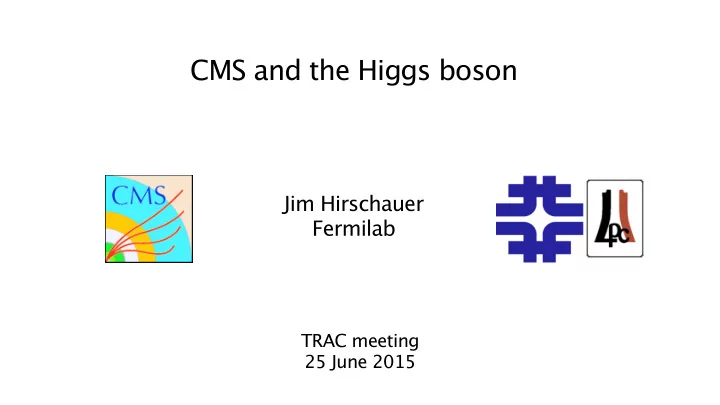

CMS and the Higgs boson Jim Hirschauer Fermilab TRAC meeting 25 June 2015
What are particles? Carbon Atom Electrons , protons , and neutrons make up the matter we experience daily. Protons and neutrons are made up of smaller particles called quarks . Our current theories describe particles as excitations of a corresponding “field” . 2
What are the four forces? 1) Electromagnetic force binds electron+nucleus. Exchange of photons -- particles of light. 2) Weak nuclear force causes nuclear decay. Exchange of W bosons . 3) Strong nuclear force binds quarks in the nucleus. 4) Gravitation binds planets, stars, galaxies, etc. 3
All the particles we know about • W and Z both “carry” • Up and down quarks weak force make up protons and • gluon carries strong neutrons. force • electron surrounds the nucleus. • muon is heavy “cousin” of electron. 4
Particle mass Mass of W boson = Mass of 80 protons = Mass of 15,000 electrons The photon and the W boson both “carry” forces. p Why is the W boson very heavy W and the photon massless? Mass of photon = 0 (It zips around at the speed of light, and won’t even sit in the scale!) 5
The Higgs field gives mass to particles. The universe is filled with the Higgs field . Crowd = Higgs field W Heavy particles ( ) interact nature.com strongly with the Higgs field. e Light particles ( ) interact weakly with the Higgs field. Massless particles ( photon , γ ) do NOT interact with the Higgs field. The Higgs boson is a vibration of Famous physicist = heavy particle the Higgs field . 6
How do we “see” the Higgs boson? Higgs bosons are created in proton collisions - only 1 Higgs boson every several billion collisions. The Higgs boson is unstable and immediately decays to other particles. Sometimes the Higgs boson decays to 2 photons , other times it decays to 4 electrons . e + e + γ γ H H e - e - We look at ALL the 2-photon and 4-electron combinations in our data to see if anything looks interesting. 7
Lake Geneva Large Hadron CMS Collider LHC SPS ATLAS Center-of-mass energy 7-14 TeV Particle Rate Proton bunches / beam ~3500 Top quark 600/minute ~1.5 x 10 Protons / bunch Higgs boson 30/minute Bunch crossing frequency 40 MHz Dark matter ? Proton collisions / bunch crossing ~40
LHC Tevatron
CMS Detector Solenoid provides 3.8T field for bending trajectories of charged particles. Silicon tracker measures momentum of e ± , μ ± , π ± , etc. Electromagnetic calorimeter ( ECAL ) measures energy of e ± , γ Hadron calorimeter ( HCAL ) measures energy of p, n, π , etc. Muon system identifies muons and measures their momenta. 10
CMS Detector CMS Detector
CMS Detector I CMS Detector Particle reconstruction and identification Pile-up 12
Particle reconstruction and identification 13
Particle reconstruction and identification Pile-up 14
Higgs boson decaying to 2 photons γ 1 H ➔ γγ γ 2 γ 2 Higgs boson decaying to 2 photons 15
Masses of all pairs of photons in data 16
Masses of all pairs of photons in data Number of photon pairs Data from 2011+2012 Expected if Higgs Boson exists with mass = 125 protons Expected if NO Higgs Boson Mass of photon pair [Units are proton masses] 17
Masses of all 4-electron groups Number of 4-electron (and muon) groups Data from 2011+2012 + Expected if Higgs Boson exists with mass = 125 protons Expected if NO Higgs Boson Mass of 4 electrons (and muons) [Units are proton masses] 18
Recommend
More recommend